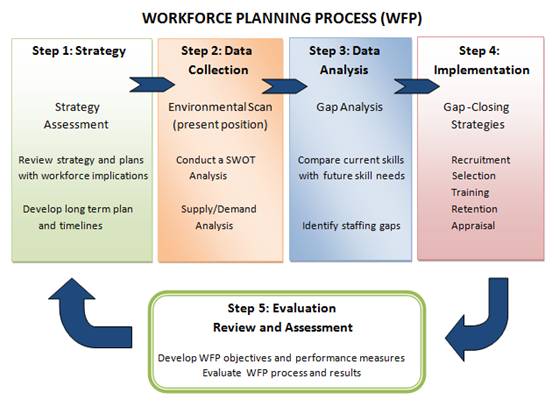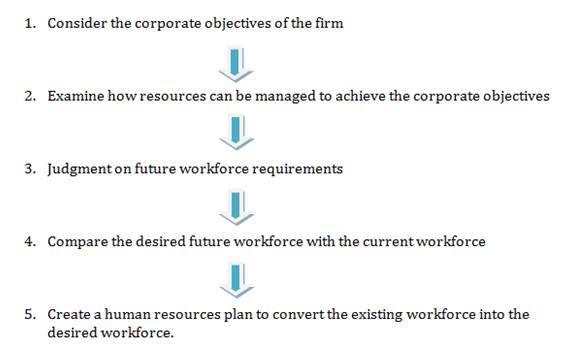Workforce Planning

Workforce planning
Workforce planning is about predicting future labour market needs. It requires an understanding of the make-up of the current workforce, an investigation into future service needs and an analysis of the type and size of workforce required to meet them.

The Workforce Planning Cycle has similarities to the formal decision making framework covered in Topic 1. Each cycle provides the firm with knowledge and additional experience of the process. Manpower planning is a continuous process as the external environment is dynamic and the underlying conditions of demand and supply alter constantly.
A number of business tools can be used to assist the process such as Ansoff's matrix, a decision making framework and SWOT, PEST and Gap analysis. The decision making is strategic and is likely to involve several functions or departments in addition to the HRM department. For example, the finance department will be required to ensure suitable funding is available for recruitment and training (and redundancy packages). Operations will be involved as the processes may be automated or outsourced.
Workforce planning is one of the core activities of human resource management. It is carried out on both a short and long term basis. It involves several processes:

- The firm's strategic plan is the starting point for the workforce plan. The firm will need to put together a workforce which provides departments with the resources to meet their short and long term objectives and to provide the firm with competitive advantage. Goals included in corporate plans could include growth and increased market share. This would have significant implications for employee requirements.
- Judgment on future workforce requirements. The firm needs to forecast the number of employees required. The skills needed across the organisation, and in which parts of the organisation particular employees are needed.
- Assessment of the current workforce. The firm needs to identify how many people they currently employ and their skills, strengths and weaknesses, age, length of service and possible retirement. The firm then needs to impose historical data to identify trends such as labour turnover and average length of service to establish to what extent the current workforce will meet future requirements if it evolves in a predictable manner.
The firm's demand for additional labour will be affected by other considerations:
- The flexibility of the existing workforce in terms of the range of skills they possess - can employees be redeployed to other departments or functions?
- The extent to which the existing workforce can be trained or retrained to provide the skills required in the future.
- The demand for labour is a 'derived' from the demand for a firm's good and services. Changes in demand patterns will influence the demand for labour.
- Changes in the external environment, such as recession, increased competition, changing tastes and fashions.
- Employee loyalty affecting labour turning.

"There are three types of workforce planning: operational, tactical and strategic. While most organisations doing it are highly engaged in short-term operational workforce planning - headcount forecasting and staffing requisitions - relatively few are highly engaged in long-term strategic workforce planning, which includes actions such as business planning, needs assessments and scenario creation."
Once estimates for future workforce requirements and skill levels are agreed, the firm will have to create plans to meet the requirements. In practice this is likely to focus on how to fill the workforce. This will involve consideration of:
- The availability of a certain type of labour within the market.
- What rivals might want from the pool of labour available.
- Additional costs, such as housing which might influence the ability to attract employees.
- Trends within the population, such as an increase in participation rates of women in the workforce, especially on a full-time basis.
- Employment and other related laws.
- Government policies.
- Future unemployment trends reflecting levels of immobility of labour.
Other factors will apply if the firm is seeking a contracting workforce in all, or some, areas. This will require an investigation of:
- 'Natural wastage' opportunities, such as voluntary redundancy or early retirement.
- Involuntary redundancies.
- De-layering and the creation of flatter management structures
- More flexible working conditions, such as job-sharing homeworking
- Greater emphasis on a small core of permanent workers and more peripheral self-employed or short-term contract employees.
It is NOT always possible to find the right people in the correct numbers and so an employer might consider:
- Outsourcing some output to sub-contractors
- Hiring externally recruited labour
- Encouraging recruitment by offering training, sponsorship or special development programmes
- Retraining current employees
- Adopting more mechanisation
- Paying more to those currently working at the company
- Spreading the work around the current workforce